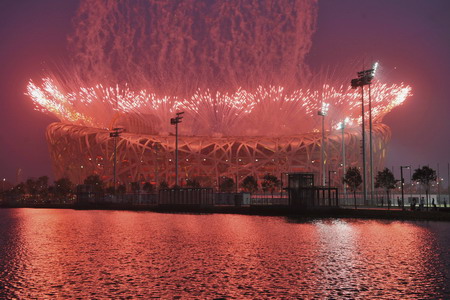Clean energy and power saving technologies have been used in constructing Beijing's Olympic venues to ensure a green Games, experts and organizers said.
|

Fireworks explode over the National Stadium, also known as the Bird's Nest, during a rehearsal for the opening ceremony of the 2008 Beijing Olympic Games at the Olympic Green in Beijing, July 16, 2008. [Agencies]
|
Ding Jianming, deputy chief engineer of the Beijing 2008 Olympic Project Construction Headquarters Office, said: "A solar power system will heat water for the daily needs of all athletes and officials in the Olympic Village during the Games."
A 6,000 sq m solar power water heating system installed in the rooftop garden at the Olympic Village, will provide hot water to the apartments and auxiliary facilities, saving 5 million kWh of electricity every year, the Games' organizers said.
Located in northern Beijing, the Olympic Village will use renewable energy such as solar power and reclaimed water to limit the amount of pollution emissions, they said.
The village will be home to more than 16,000 athletes and sports officials during the Olympics, they said.
During the Games, the two energy sources will provide the village with 7.89 million kWh of power, equivalent to the amount produced by burning 3,077 tons of coal. These renewable energy sources will reduce carbon dioxide emissions by 8,000 tons, they said.
The village is just one of 37 "competition" venues - 31 in Beijing and six in co-host cities - and 14 "non-competition" that will be used during the Games, the organizers said.
Forty-two gold medals will be won at the National Aquatics Center - a blue bubble-wrapped structure, also known as the Water Cube - which will host the swimming, diving and synchronized swimming events, they said.
The 17,000-seat venue was designed with water saving in mind, the organizers said.
The building's outer surface and roof can collect 10,000 tons of rainwater, 70,000 tons of clean water and 60,000 tons of swimming pool water a year, and the venue as a whole will save 140,000 tons of recycled water a year, the organizers said, without elaborating.
Zhao Zhixiong, general manager of the Water Cube, said: "Our goal is to build the Water Cube into a swimming stadium that can save water to the greatest extent."
Last week, Yang Weiguang deputy director of the Beijing municipal science and technology commission, said: "Beijing's Olympic venues have widely used energy-saving technologies, environmentally friendly new materials, clean and renewable energy."
The National Stadium's steel structure, Peking University Gymnasium's siphon drainage system, Qingdao Olympic Sailing Center's seawater source heat pump technology and Shenyang Wulihe Stadium's reclaimed water treatment system - are all examples, he said.